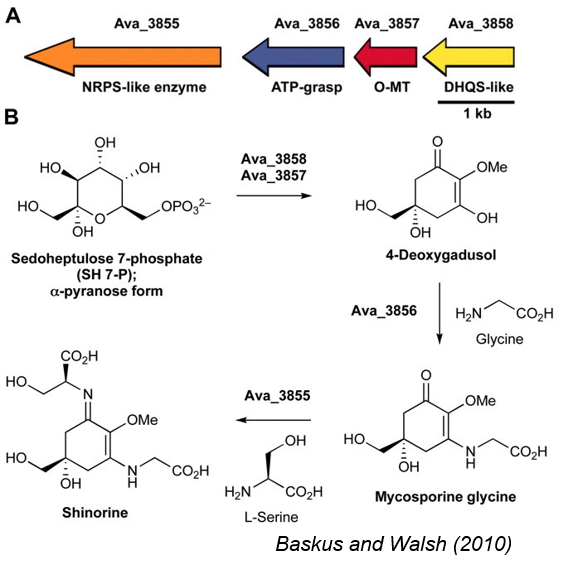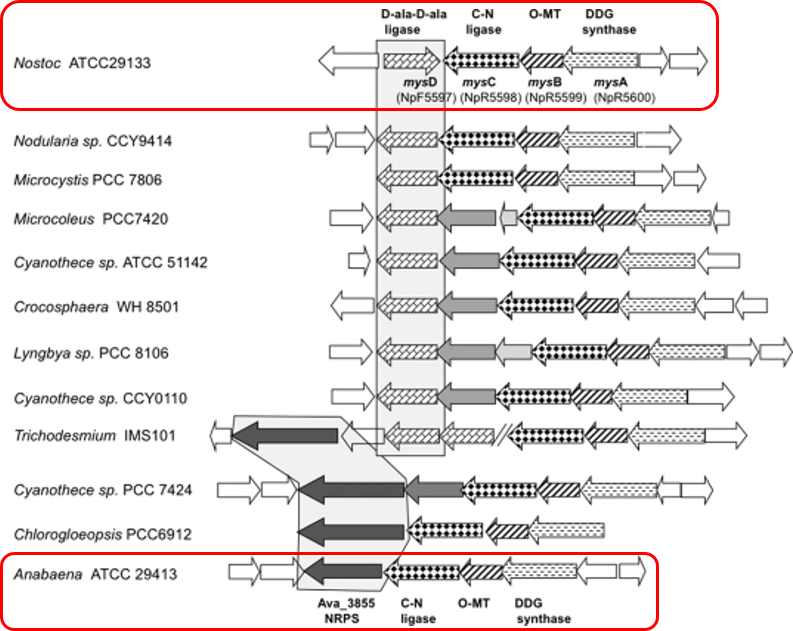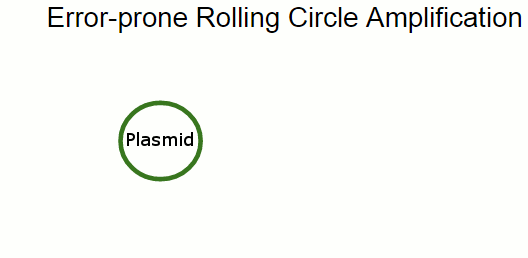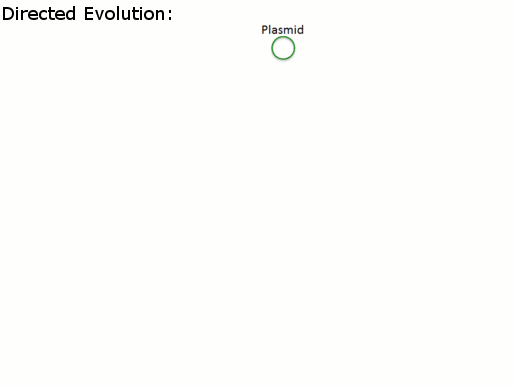Difference between revisions of "Team:SF Bay Area DIYBio/Description"
| Line 1: | Line 1: | ||
{{SF_Bay_Area_DIYBio}} | {{SF_Bay_Area_DIYBio}} | ||
| − | + | ___NO_TOC___ | |
| + | ==Bio Sun Block (Evolved Bacterial Sunscreen)== | ||
| − | + | ===Introduction=== | |
| − | + | No, not sunscreen ''for'' bacteria - sunscreen made ''by'' bacteria. We are going to make e.coli bacteria create shinorine, a UV absorbing compound that is currently being extracted from algae as an eco-friendly sunscreen. | |
| − | + | Genetic Engineering is arguably the greatest leap forward in human understanding and manipulation of nature in the whole history of mankind, above and greater than the invention of fire and the wheel combined. This project makes use of Genetic Engineering to force a bacteria to create a compound that it would never make and then use the tools of evolution to enhance that ability. | |
| − | + | E.coli can easily be killed by UV light. By equipping it with the genes to produce UV absorbing compounds, we expect that the E. coli will become somewhat UV resistant as well. After designing the process, we want to make it better, so we will employ “directed evolution” to make the process better. We think that if we stress the bacteria with UV that they will start to evolve better and more efficient mechanisms to protect themselves from UV. | |
| − | + | So that is our project: start some bacteria making sunscreen then subject them to a lot of sunshine and they will evolve to make more and better sunscreen. | |
| − | + | ====Physics of sunscreen==== | |
| − | + | Sunscreens are chemical compounds that absorb or reflect UV light, preventing it from damaging cells. We put sunscreen on our skin to protect the underlying skin cells from the damaging UV in sunlight. The Sun Protection Factor (SPF) rating of sunscreen essentially measure how much longer it allows someone to stay in the sun before getting a sunburn caused by UV-B light (290-320 nanometers). This is an imperfect measure of skin damage because invisible damage and skin aging are also caused by ultraviolet type A (UV-A, wavelengths 320–400 nm), increasing the risk of malignant melanomas. | |
| − | + | UV rays carry high energy and are suspected of causing cancer through damage to the skin's DNA. High energy in sunlight comes in two forms:</p> | |
| − | + | - UV-A (320-400 nanometers) | |
| − | + | - UV-B (290-320 nanometers) | |
| − | + | ||
| − | + | ||
| − | + | The UVB waves tend to receive more criticism than the less energetic UVA waves. But, in actual fact, both UVB and UVA can damage the skin. Unfortunately, the chemistry of sunscreen, in most cases, does not enable the blocking of UVA as effectively, if at all, as they do UVB. | |
| − | + | Note that the germicidal UV lights we use in the laboratory (e.g. built into the biosafety cabinet) emit the even short wavelength and even higher energy UV-C light (wavelengths 100–280nm). These wavelengths do not actually occur in natural sunlight, because they are absorbed by the Earth's atmosphere. | |
<h4>Mycosporine-like amino acids</h4> | <h4>Mycosporine-like amino acids</h4> | ||
| − | + | Mycosporine-like amino acids (MAAs) are small secondary metabolites produced by organisms that live in environments with high volumes of sunlight, usually marine environments. The structures of over 30 Mycosporine-like amino acids have been resolved and all contain a central cyclohexenone or cyclohexenimine ring and a wide variety of substitutions. The ring structure is thought to absorb UV light and accommodate free radicals. All MAAs absorb ultraviolet light, typically between 310 and 340 nm. It is this light absorbing property that allows MAAs to protect cells from harmful UV radiation. They are commonly described as “microbial sunscreen” but their function is not limited to sun protection. | |
| − | + | Though most MAA research is done on their photo-protective capabilities, they are also multifunctional secondary metabolites that have many cellular functions. MAAs are effective antioxidant molecules and are able to stabilize free radicals within their ring structure. In addition to protecting cells from mutation via UV radiation and free radicals, MAAs are able to boost cellular tolerance to desiccation, salt stress, and heat stress. | |
| − | + | ===''Anabaena variabilis'' shinorine gene cluster=== | |
| − | + | Baskus and Walsh (2010) identified a gene cluster in A. variabilis that produced shinorine, a well-studied MAA. | |
| + | |||
| + | The U. Minnesota 2012 iGEM team successfully transformed the entire gene cluster, but did not observe the production of shinorine, the final metabolite in the pathway. No parts submitted to Registry. | ||
| + | |||
| + | [[File:Baskus and Walsh.png|400px]] | ||
| + | |||
| + | ====Alternative Mycosporine enzymes==== | ||
| + | The Minnesota 2012 team was not able to get the final step in the pathway, so we also searched for alternative enzymes in other cyanobacteria | ||
| + | |||
| + | ''Nostoc punctiforme ATCC 29133'': final enzyme produces shinorine and porphyra-334 | ||
| + | |||
| + | We identified 7 other homologous genes from known shinorine producing cyanobacteria | ||
| + | |||
| + | [[File:Homologs.png|600px]] | ||
| + | |||
| + | ===Directed Evolution=== | ||
| + | UV resistance is an ideal target for Directed evolution: | ||
| + | |||
| + | - Introduce mutations | ||
| + | |||
| + | - Select for UV resistance | ||
| + | |||
| + | - Repeat! | ||
| + | |||
| + | [[File:DE schematic.png]] | ||
| + | |||
| + | In principle, we can rely on the UV exposure to introduce mutations, and select for the phenotype we want to optimize. In practice, we use error-prone Rolling Circle Amplification to introduce mutations just in the engineered plasmid carrying the shinorine biosynthesis genes: | ||
| − | |||
[[File:RCA Animation.gif]] | [[File:RCA Animation.gif]] | ||
| + | |||
| + | If we go directly from transformation to growing in liquid medium, and then do the selection in liquid medium, we never actually need to grow isolates during each round of Directed Evolution. | ||
| + | |||
| + | This could in theory lead to a greatly simplified protocol: | ||
| + | |||
[[File:Directed Evolution Animation.gif|800px]] | [[File:Directed Evolution Animation.gif|800px]] | ||
Revision as of 13:42, 21 November 2015
Contents
Bio Sun Block (Evolved Bacterial Sunscreen)
Introduction
No, not sunscreen for bacteria - sunscreen made by bacteria. We are going to make e.coli bacteria create shinorine, a UV absorbing compound that is currently being extracted from algae as an eco-friendly sunscreen.
Genetic Engineering is arguably the greatest leap forward in human understanding and manipulation of nature in the whole history of mankind, above and greater than the invention of fire and the wheel combined. This project makes use of Genetic Engineering to force a bacteria to create a compound that it would never make and then use the tools of evolution to enhance that ability.
E.coli can easily be killed by UV light. By equipping it with the genes to produce UV absorbing compounds, we expect that the E. coli will become somewhat UV resistant as well. After designing the process, we want to make it better, so we will employ “directed evolution” to make the process better. We think that if we stress the bacteria with UV that they will start to evolve better and more efficient mechanisms to protect themselves from UV.
So that is our project: start some bacteria making sunscreen then subject them to a lot of sunshine and they will evolve to make more and better sunscreen.
Physics of sunscreen
Sunscreens are chemical compounds that absorb or reflect UV light, preventing it from damaging cells. We put sunscreen on our skin to protect the underlying skin cells from the damaging UV in sunlight. The Sun Protection Factor (SPF) rating of sunscreen essentially measure how much longer it allows someone to stay in the sun before getting a sunburn caused by UV-B light (290-320 nanometers). This is an imperfect measure of skin damage because invisible damage and skin aging are also caused by ultraviolet type A (UV-A, wavelengths 320–400 nm), increasing the risk of malignant melanomas.
UV rays carry high energy and are suspected of causing cancer through damage to the skin's DNA. High energy in sunlight comes in two forms:</p>
- UV-A (320-400 nanometers)
- UV-B (290-320 nanometers)
The UVB waves tend to receive more criticism than the less energetic UVA waves. But, in actual fact, both UVB and UVA can damage the skin. Unfortunately, the chemistry of sunscreen, in most cases, does not enable the blocking of UVA as effectively, if at all, as they do UVB.
Note that the germicidal UV lights we use in the laboratory (e.g. built into the biosafety cabinet) emit the even short wavelength and even higher energy UV-C light (wavelengths 100–280nm). These wavelengths do not actually occur in natural sunlight, because they are absorbed by the Earth's atmosphere.
Mycosporine-like amino acids
Mycosporine-like amino acids (MAAs) are small secondary metabolites produced by organisms that live in environments with high volumes of sunlight, usually marine environments. The structures of over 30 Mycosporine-like amino acids have been resolved and all contain a central cyclohexenone or cyclohexenimine ring and a wide variety of substitutions. The ring structure is thought to absorb UV light and accommodate free radicals. All MAAs absorb ultraviolet light, typically between 310 and 340 nm. It is this light absorbing property that allows MAAs to protect cells from harmful UV radiation. They are commonly described as “microbial sunscreen” but their function is not limited to sun protection.
Though most MAA research is done on their photo-protective capabilities, they are also multifunctional secondary metabolites that have many cellular functions. MAAs are effective antioxidant molecules and are able to stabilize free radicals within their ring structure. In addition to protecting cells from mutation via UV radiation and free radicals, MAAs are able to boost cellular tolerance to desiccation, salt stress, and heat stress.
Anabaena variabilis shinorine gene cluster
Baskus and Walsh (2010) identified a gene cluster in A. variabilis that produced shinorine, a well-studied MAA.
The U. Minnesota 2012 iGEM team successfully transformed the entire gene cluster, but did not observe the production of shinorine, the final metabolite in the pathway. No parts submitted to Registry.
Alternative Mycosporine enzymes
The Minnesota 2012 team was not able to get the final step in the pathway, so we also searched for alternative enzymes in other cyanobacteria
Nostoc punctiforme ATCC 29133: final enzyme produces shinorine and porphyra-334
We identified 7 other homologous genes from known shinorine producing cyanobacteria
Directed Evolution
UV resistance is an ideal target for Directed evolution:
- Introduce mutations
- Select for UV resistance
- Repeat!
In principle, we can rely on the UV exposure to introduce mutations, and select for the phenotype we want to optimize. In practice, we use error-prone Rolling Circle Amplification to introduce mutations just in the engineered plasmid carrying the shinorine biosynthesis genes:
If we go directly from transformation to growing in liquid medium, and then do the selection in liquid medium, we never actually need to grow isolates during each round of Directed Evolution.
This could in theory lead to a greatly simplified protocol:





